|
 Aethera Campaign Setting Part Twenty - Bestiary II - Kyton to Phalanx TRIGGER WARNING: Kytons are chock full of blood and body horror. Those sensitive to such topics, please take appropriate precautions. Scroll down really fast or something, I don’t know. Kytons in Aethera lurk beneath the surface of the everyday world like a cancer, forging endless horrors in service to the ideals of the great Machine they revere. The prose here is very purple, to the point where it can be difficult to get relevant information out of it. But the gist is that the kytons are shadowy puppeteers that are rarely even seen in the system, working under the auspices of the Choir of the Machine to remake the system into their vision of perfection. The Choir of the Machine is one part sadistic cult and one part industrial death-spiral. Their machines are needlessly complex and their rituals needlessly cruel. The exact nature of the Machine is known only to the Choir, but don’t worry, they’re more than willing to help you understand it.  A kyton-run dungeon is going to be a sadistic gauntlet of traps and industry for no other reason than to exist. Typically they will have no external power source, operating entirely off a kyton’s ability to control chains. They may rearrange themselves around an adventuring party, or the entire dungeon may be a grand device needing only the right series of activations to spring to grand and horrific purpose. DMs are encouraged to throw trap after trap at the PCs without letting them see the actual kyton behind it all, because that’s just how kytons do. DMs are also encouraged to play with players’ metagame knowledge and swap around abilities, because kytons are heavily into self-modification. “Battle with kytons should never seem safe or predictable.” Additionally, kytons take great pains to conceal their presence from the Material Plane. Knowledge checks related to kytons are at a base DC of 25 to even know of their existence and vague details of the kyton subtype. And even that won’t help you much, because other than terpsikhore (below), every kyton is supposed to be more or less unique. Aetheran kytons are all immune to pain and have the see in darkness ability, and kytons from other sources should have these abilities added, as well as changing any plane shifting abilities to Greater Shadow Walk. When the Taur leaped into the system, the loss of their priests’ contact with their god upset their power structure, and into this vacuum stepped the kytons, offering an alliance where the kytons would provide technology and knowledge, and the taur would provide… meat. It has been a profitable partnership for both sides. Kyton society on each planet is supposedly overseen by a Conductor (Who could also be called an Architect, either in a recurring typo or an intentional synonym), operating in its own manner but always in accordance with the will of the Machine. Taking a lawnmower to the flowery bits, we learn Akasaat’s conductor is known only as the Enraptured Luminary, Aigog rules on Kir-Sharaat, and Glua-Mahab is spoken of in ancient okanta legends as a beast of steel and shadow taller than mountains. No evidence is available to Prime Material denizens that the Conductors actually exist, though. A similar lack of evidence points to the existence of the Prime Mover, an overseeing power above even the Conductors. The only mortals who even whisper about it are insane scholars of the Score. 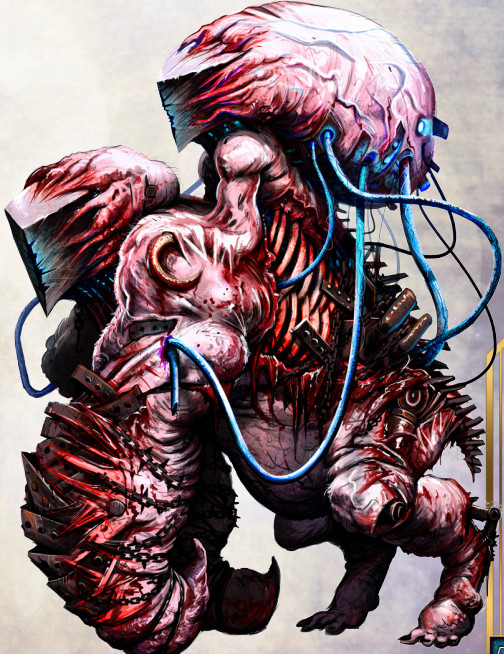 Who rule Bartertown? The Paragon Project did not spring purely from the minds of man, nor were the infused and Paragons its only result. Kytons planted nightmares of erahthi dominion in the minds of Hierarchy officials, urging them to moral atrocities to avoid this fate, while disguised kytons aided researchers in the Project, able to smuggle “failures” into the Shadow, where the real experiments began. An aloadai kyton is a gestalt of two infused, the lower one pumped full of muscle-boosting mutagen and wrapped around a mechanical endoskeleton, while the top one has its superfluous flesh cut away and its head injected with mind-boosting alchemical fluids, the pair laced together at the ribcage and their minds merged into one. The result is a powerful physical combatant and a psychic terror all in one. Aloadai are used as commanders of lesser kyton, particularly terpsikhore, using their mental abilities to remain in contact with both local forces and any distant aloadai. Isolated kyton outposts may be run by an aloadai who serves as the outpost’s message center. Their mind-reading abilities make them natural interrogators, but the kytons prefer to extract truths through torture rather than lift them directly from a mind, seeing the resultant information as “purer.” Rare sights aboard taur vessels normally, shortly before a raid on a Material settlement, kytons will appear from the Shadow with a pair of aloadai and a horde of terpsikhore. The taur like these guys and study them every chance they get to try and learn about the kytons as a whole. Built into the twisted minds of the aloadai are periodic flashes of memory of what they used to be, stunning moments of clarity that act to further refine the growth of all aloadai, as these moments of sickening lucidity propagate through the psychic network, shocking the aloadai anew with each aloadai it touches. A single aloadai is a CR 8 outsider with a handful of subtypes, 21 AC and two slams at +14. It has 19 SR, DR 10/good or silver, and regenerates, which is also bypassed by good and silver, as well as electricity. It can cast a number of psychic spells, mostly offensive, but including Instigate Psychic Duel. It has Combat Casting, a few metamagic feats (Including Traumatic Spell), Awesome Blow, and Improved Bull Rush, so it can knock you around in combat. But wait, there’s more! It can communicate telepathically with any aloadai within 3 miles or any other creature within 50 feet. If two aloadai are within 100 feet of each other, they become linked to each other, sharing sensory information along with the boost from the spell. An aloadai’s two minds allow it two initiative counts in combat, with one controlling the body and the other the mind, each one capable of a full round of appropriate actions. Their powerful minds also grant them their Int bonus to AC and saves versus psychic spells, and half that bonus to kytons within 100 feet. And finally, its unnerving stare invokes paranoia in the target, causing them to treat all enemies as flanking them. And because the aloadai has two heads, you need to roll twice to avoid its gaze. Alone, one doesn’t seem like much of a threat if you’re packing the standard golf bag of swords, but they’re rarely encountered alone, coming in pairs or a pair backed up by upwards of half a dozen terpsikhore. I like the mechanics, but the design just makes me go  . I met the lady that did all the kyton designs when I was at PaizoCon. Nice woman, soft-spoken. . I met the lady that did all the kyton designs when I was at PaizoCon. Nice woman, soft-spoken. I can’t pick my nooooose The kyton hate the okanta for some reason. The result is the ceres kyton, broken and twisted in mind, body, and spirit until all that remains is the okanta’s bestial bloodlust, a pure desire to kill and rend and rip and tear that is then shackled and bridled (Literally, a bit and bridle is welded into their jaw) and used to retrieve subjects alive for the kyton’s twisted experiments. Treated as little more than hunting hounds, ceres are kept in cramped cages aboard taur ships or on the Shadow, ushered out and onto the Material by greater kytons with orders to retrieve a target or small group and kill all witnesses. A ceres is a CR 4 outsider with DR and regeneration 5, bypassed by good or silver. They have AC 16 and three natural attacks: Two integrated scimitars, and an okanta’s gore, all at +7. The scimitars are treated as natural weapons when attacking, but can be enhanced or sundered like manufactured weapons. Their main trick is to ensnare a target in chains, which is basically a ranged grapple. Once they have something grappled (Multiple ceres can act in concert to grapple larger creatures and make the grapple harder to resist), they can automatically drag it with them. A ceres’ unnerving gaze focuses the victim’s attention on the ceres, granting all other enemies concealment against the victim. A single one is probably not much of a problem for a party above 1st level if they’re packing silver, and would get absolutely pasted by a 4th-level party, but these are rarely encountered alone, coming in groups of three or more and occasionally accompanied by a greater kyton. These guys are okay, they do their job and make you feel a little sad about the okanta. 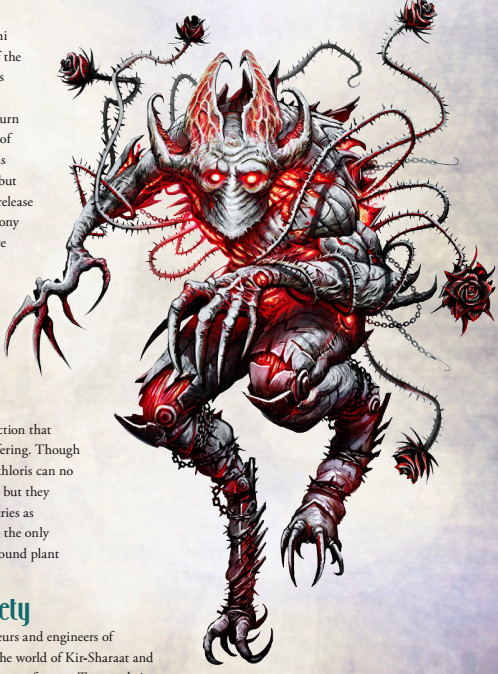 Groot a la Giger. The Shadow of Kir-Sharaat is a world of nature perverted to industry, great factory-trees belching smoke into noxious skies. Small wonder, then, that the kytons have seen fit to marry the biology of the erahthi with burning oil to create the khloris kyton. Eternally burning, but never consumed, a khloris longs for the sweet embrace of death, twisting its mind into a destructive and suicidal nature, gladly hurling itself into battle against formidable foes in the hopes of being granted explosive release from its torment. Used by the kytons as saboteurs and instigators of conflict, they blight, burn, and infect the great forests bit by bit. Although they’ve lost the erahthi ability to speak to plants, they can still hear the agonized cries as they burn. A khloris is CR 3 with 15 AC, DR 5/good or silver (The constant burning negates the kyton’s normal regeneration), and fire resistance. They have two claws at +6 that do a bit of additional fire damage, and can cast Produce Flame at will and Blight 3 times a day. They can spray their internal oil in a cone, increasing Acrobatics DCs in the area, and anyone coated in the oil is sickened and has vulnerability to fire. The oil can be washed off a creature or square with a full-round action and a gallon of liquid. They can throw their razor-sharp flowers as a splash weapon, and when they hit 0 hp they explode, dealing fire damage and setting things on fire, incidentally completely obliterating their body and hiding evidence of kyton involvement. They’re supposedly very prevalent, though, which just leads to a lot of eyewitnesses saying “We fought a burning erahthi and they totally exploded, officer!” Finally, their unnerving gaze entangles victims. They usually operate alone, but can be encountered in groups of up to 8. The group noun is an inferno of khloris.  Butchershop quartet. Humanity is meat and music. A human alone is nothing, but together they can accomplish incredible things. So it is with the terpsikhore kytons, the massed hordes of the kytons, voiceless alone, but singing great paeans to the Machine when joined together. Even the weakest of them can find purpose and power when joined with their fellows, a concept the kytons find beautiful. Formed from the cast-off flesh from more successful experiments, a single terpsikhore has only a 20th of a soul. This fragmentary existence keeps the terpsikhore docile and grants them a fragmented but terrifyingly cohesive sense of self. Terpsikhore is both singular and plural, one voice, countless hands. A lone terpsikhore is hardly a threat, even to a commoner: CR 1 with only 12 AC, 15 hp, and 2 1d4 claws at +2. Their split soul doesn’t grant them any DR, regeneration, or unnerving gaze and they have no special abilities when on their own. But they are rarely encountered alone. Up to 20 can be encountered at a time (Group noun: chorus), and they have some special abilities that only function in a group. First off, they have a kind of hive mind that syncs up their reactions and senses. Terpsikhore always act on the same initiative and are all aware of anything any member is aware of. Second, terpsikhore adjacent to each other share flesh and organs in a horrid symbiosis, treating the entire group as having one hit point total equal to the hp of all the members, any that separate from the group take the average remaining hp. Third and most important, adjacent kytons can join together in discordant song to produce various effects, depending on how many join together. This takes a full-round action for each participating terpsikhore, but nothing says everyone in the group needs to participate. A smart DM could do some real damage with these guys in formation, letting the frontliners tie up the tank while those in the back dropped sick beats all over the party. Two terpsikhore together can create a Sound Burst. Three buff their friends, boosting claw damage. Four produces a mass Cure Light Wounds, which can get really mean if you have a party that just tries to damage race through mooks. Crushing Despair, Wall of Sound, Shout, and Song of Discord are all in the terpsikhore toolbox as their boy band gets more members, as well as some that don’t reproduce spell effects, like a generalized damage AoE or magic disruption. 20 terpsikhore together can produce a Blasphemy effect as they chant the ultimate paean to the Machine, blasting the truth of the kytons into people’s minds. Those that would be killed by this are instead knocked out by charisma damage and gain two insanities: Technomania and psychosis. I like these guys, they’re thinking man’s minions. Needing more than just a couple buffs on the barbarian to handle effectively, I could see some parties hauling out the combat maneuver rules to yank individuals out of the group and focus them down. 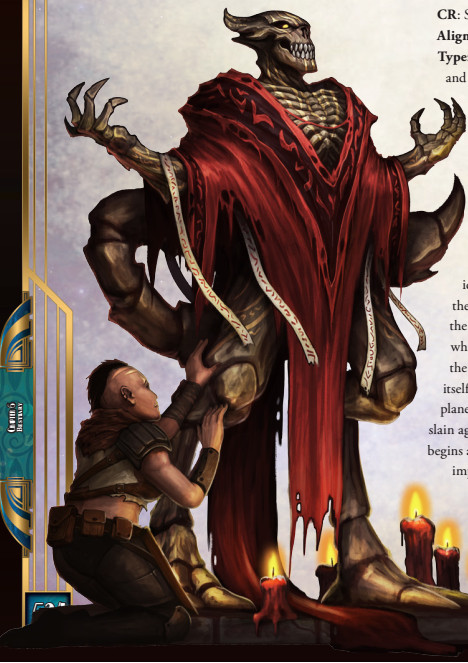 The dimensional lock effect on the Aethera system prevents outsiders from the Outer Planes from transferring back home. When such an outsider is killed, their soul is not drawn back to the Outer Planes, nor is it pulled into the star to be reincarnated. Their flesh decays, while their soul lingers on the Ethereal Plane, becoming warped and imprisoned by the dimensional lock. Forever bound to the Material Plane now, the imprisoned outsider is still immortal, and over the course of millennia may find themselves drifting from the moral and ethical alignments enforced by their prior home planes. Not only that, the raw spark of divinity from their planar origin can be fed by worshippers and leveraged by the Living Idol to grant powers in much the same way a god might. These living idols establish cults in the dark corners of the world, attracting the downtrodden and desperate. Living idols are unpredictable, often dangerous, and never what they seem. The Living Idol template itself doesn’t change the numbers much. Living idols can be any alignment and become native outsiders. If the base outsider had spell resistance, it gets better, and it loses any teleportation or summoning abilities it had. Most of the changes provided by the template are just adjusting its immortality and dictating how it interacts with worshippers. When a living idol dies, it leaves an imprint on the Ethereal Plane and a sort of afterimage on the Material. Its body reconstitutes itself over 1d10 days, but you can start the process over by blasting the afterimage. The only way to actually kill an imprisoned outsider is with a carefully-worded Wish or Miracle spell, or by transporting it to the Outer Planes and killing it there. Now, an imprisoned outsider can apparently just live without much difficulty, but to become a true living idol it needs to accept the supplication of worshippers. This is done by linking the worshipper to the idol over the course of an hour. This linking cannot be magically coerced, and usually takes the form of a ceremony suited to the idol’s tastes. The idol gains new powers based on how many followers it has, and some of these powers can be given to the worshippers in some form or another. A living idol has a rank from 1 to 9, based on the number of followers, and some powers are restricted to higher-rank idols. Some of the powers available include Cha to AC, granting followers a +4 bonus to an ability score, constant Nondetection or Protection From [Alignment], Control Weather 1/month, channeling energy like a cleric, locating/possessing/slaying/seeing through the eyes of worshippers, or granting immortality to a handful of followers. Gaining more powers results in small boosts to HP and CR, and if the idol’s followers drop below the minimum threshold needed to maintain a rank, the idol immediately loses access to a power. This power is not without a cost, however. If a living idol is not propitiated with sacrifices on a monthly basis, it begins to take drain to its mental ability scores. If these drop to 0, it falls into a state of torpor, only capable of using telepathy, if it even could in the first place. It then begins taking daily Constitution drain, hardening into a statue at 0. Sacrifices can be food, items, or blood of living creatures, but must be freely offered by the sacrificer. Animal sacrifice is okay, but the life of a thinking being is worth more in terms of sacrifice. An idol that accepts a blood sacrifice automatically becomes evil. A sample living idol’s statblock is provided, an osyluth devil with 1150 worshippers and 7 powers. The names and dispositions of a few other known living idols are also provided, and we may get stats for them in the Aethera Field Guide. Contract is a Lawful Neutral kolyarut inevitable who has mostly maintained his pre-imprisonment outlook and now runs a mercenary company dedicated to maintaining law and order and enforcing contracts. Nairaia the Giver is a Chaotic Evil monadic deva angel who operates out of a captured Hierarchy battlecruiser, her cult offering “peace from all wars” and slaughtering those who refuse her message of goodwill. And Shevrix is a Neutral Good leukodaemon who wanders Akasaat as an itinerant pilgrim and healer, often using its knowledge of illness to develop plague vaccines.  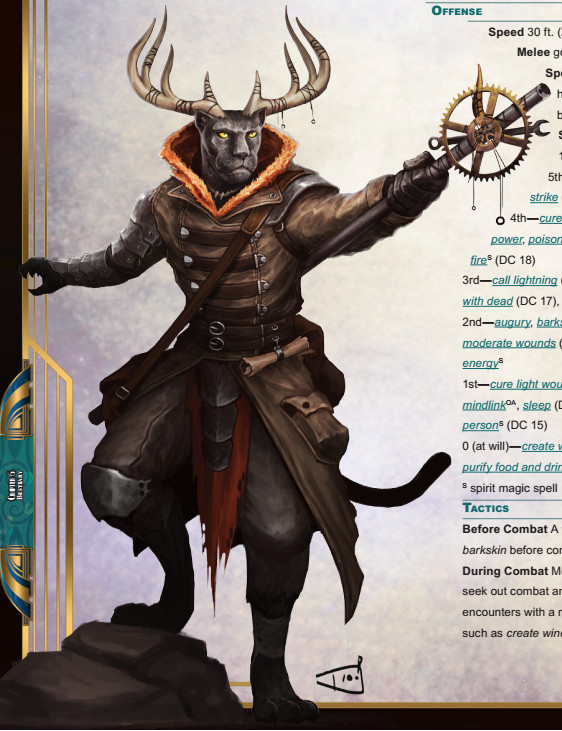 Say “bacon” one more time… Okanta NPCs highlight the magical themes of the race, with a level 15 steelblood bloodrager called a “runebreaker” and a level 10 unsworn shaman who has come to the wastelands of Akasaat to study the spirits of the barren land. The runebreakers are a tradition similar to the Vanguard of Akasaat, developing in parallel to protect their peoples from enemy magic-users. Each runebreaker abandons their name, donning a title passed down from previous runebreakers, such as Breaker of the Mountain 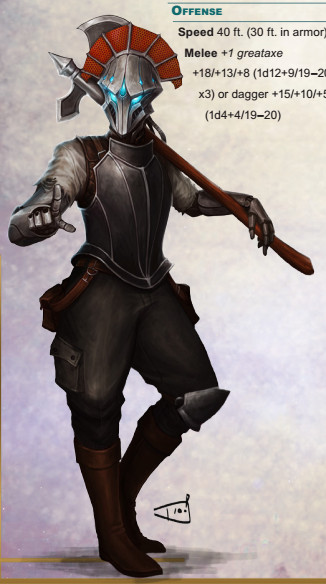 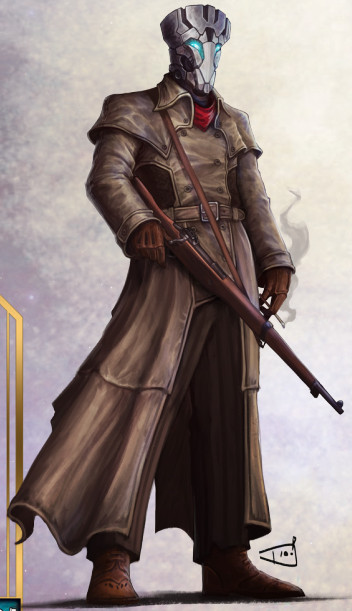 He’s only smoking because it looks cool. Phalanx NPCs are universally veterans of the Century War, and provided for our edification are a level 4 gunslinger working as a freelancer and a level 11 two-handed fighter operating as a mercenary captain. Next update will finish out the campaign setting with the last pieces of the bestiary: Symbionts, taur, and zahajin.
|
|
|
|

|
| # ¿ Apr 23, 2024 21:43 |


